Tornadoes are one of nature’s most destructive forces. These violent storms can cause immense damage to buildings, infrastructure, and the lives of those caught in their path. While tornadoes vary in size and strength, one question that often comes to mind is: what was the biggest tornado ever recorded? In this article, we will delve into the history of tornadoes, explore the factors that contribute to their size and intensity, and uncover the details surrounding the largest tornado on record.
Tornadoes, often referred to as twisters, are rapidly rotating columns of air that are in contact with both the surface of the earth and a cumulonimbus cloud. They are typically characterized by a funnel-shaped cloud extending from the sky to the ground. These destructive storms are most commonly associated with severe thunderstorms, but they can also occur in tropical cyclones and even snowstorms.
**What was the biggest tornado?**
The biggest tornado ever recorded in terms of width was the El Reno tornado, which struck Oklahoma on May 31, 2013. This massive tornado had a maximum width of 2.6 miles (4.2 kilometers), making it the widest tornado ever observed. The El Reno tornado was also classified as an EF5 tornado, the most severe category on the Enhanced Fujita Scale, with wind speeds estimated to have reached over 296 miles per hour (477 kilometers per hour).
**The El Reno tornado: a monstrous storm**
The El Reno tornado formed as part of an outbreak of severe weather across the central United States. It was spawned by a supercell thunderstorm, which is a long-lived and rotating thunderstorm capable of producing large hail, damaging winds, and tornadoes. The El Reno tornado rapidly intensified and grew exceptionally large, stretching across the open countryside of rural Oklahoma.
This massive tornado caused widespread destruction, including leveling entire neighborhoods and throwing vehicles across the landscape. Unfortunately, the El Reno tornado claimed the lives of several storm chasers, highlighting the dangers associated with these extreme weather events.
**Factors influencing tornado size**
Several factors contribute to the size and intensity of a tornado. These include atmospheric conditions, such as wind shear and instability, which provide the necessary ingredients for tornado development. The size and strength of a tornado are also influenced by the characteristics of the parent thunderstorm, including the presence of a rotating updraft known as a mesocyclone.
Additionally, the geography of the area where the tornado forms can impact its size. In open rural areas, tornadoes often have a larger diameter compared to those that form in densely populated urban areas. This is because urban environments can disrupt the flow of air, causing the tornado to become more confined and narrower.
**Other notable large tornadoes**
While the El Reno tornado holds the record for the widest tornado, there have been other notable large tornadoes throughout history. The Tri-State Tornado, which occurred on March 18, 1925, remains the deadliest tornado on record, claiming approximately 695 lives in Missouri, Illinois, and Indiana. This tornado traveled for a distance of 219 miles (352 kilometers) and had a maximum width of approximately 1 mile (1.6 kilometers).
Another significant tornado is the Hallam, Nebraska tornado, which occurred on May 22, 2004. This tornado had a maximum width of around 2.5 miles (4 kilometers) and caused extensive damage to the town of Hallam and surrounding areas. Despite its size, no fatalities were reported, thanks in part to advanced warnings and the community’s preparedness.
**Frequently Asked Questions**
What is the average size of a tornado?
The average size of a tornado can vary greatly. Most tornadoes have a diameter of a few hundred feet to a few hundred yards. However, larger tornadoes can have diameters measuring several miles.
What is the strongest tornado ever recorded?
The strongest tornado ever recorded was the tornado that struck the town of Moore, Oklahoma, on May 3, 1999. This tornado was rated as an EF5 on the Enhanced Fujita Scale, with estimated wind speeds exceeding 300 miles per hour (483 kilometers per hour).
What factors can cause a tornado to dissipate?
Several factors can lead to the dissipation of a tornado. These include a decrease in the energy and instability of the atmosphere, an interruption in the inflow of warm, humid air, and changes in wind shear that disrupt the storm’s rotation.
Can tornadoes be predicted?
While tornadoes can be challenging to predict with pinpoint accuracy, meteorologists use a combination of radar data, satellite imagery, weather models, and ground observations to issue tornado watches and warnings. Advanced warning systems have greatly improved over the years, providing communities with valuable time to take shelter before a tornado strikes.
Final Thoughts
Tornadoes are awe-inspiring yet terrifying natural phenomena. Throughout history, many devastating tornadoes have left a lasting impact on communities and serve as a grim reminder of nature’s power. While the El Reno tornado holds the record for the widest tornado ever recorded, it’s essential to remember that tornadoes come in various shapes and sizes, and each one poses a significant threat to life and property. Staying informed, being prepared, and heeding the advice of meteorologists and local authorities are crucial steps in mitigating the impact of these destructive storms.
